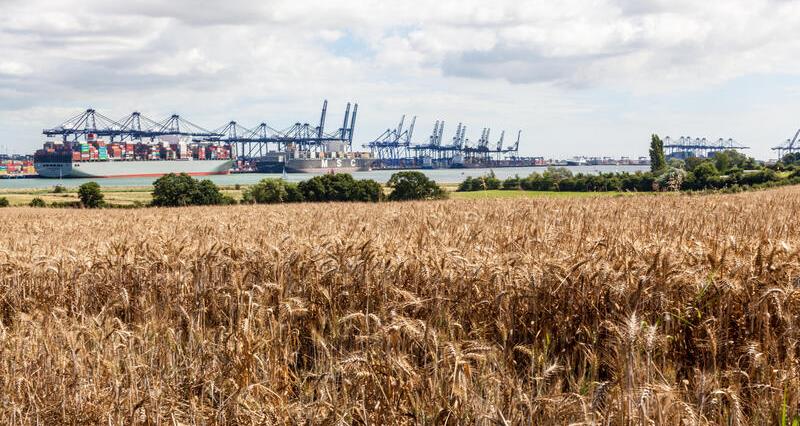Why is the government holding a consultation?
On 2 April President Trump announced a 10% tariff on top of existing US duties on imports from the UK starting from 5 April.
While the UK Government is working to reach a trade agreement with the US that would exempt the UK from the ‘reciprocal’ tariffs, it is also considering measures it could take in response to the US additional tariffs.
Therefore, the government is consulting businesses on the impacts of potential tariff measures on US goods.
In order to contribute to the government’s strategy, the NFU is asking for your thoughts on the that should not be targeted by tariffs.
Your feedback will inform our response to the government’s .
What does the UK currently import?
The US is a key source of agricultural inputs used by the farming industry.
The table below shows the total volume (kg) of UK imports of key agricultural inputs (listed with their commodity codes) from around the world and from the US in 2024. The right-hand column details the share of US imports as a percentage of total UK imports.
| UK imports (kg) in 2024 | Total imports | Imports from the US | US% |
| 10 Cereals | 2,824,569,943 | 196,316,735 | 7.0 |
|
2,824,569,943 | 196,316,735 | 7.0 |
| 12 oilseeds and oleaginous fruits; miscellaneous grains, seeds and fruit; industrial or medical plants; straw and fodder | 1,073,785,444 | 169,495,382 | 15.8 |
|
1,073,785,444 | 169,495,382 | 15.8 |
| 23 residues and waste from the food industries; prepared animal fodder | 2,731,571,381 | 478,013,972 | 17.5 |
|
624,568,269 | 338,510,475 | 54.2 |
|
2,107,003,112 | 139,503,497 | 6.6 |
|
103,567,534 | 3,529,069 | 3.4 |
| 28 Inorganic chemicals: organic or inorganic compounds of precious metals, of rare-earth metals, of radioactive elements or of isotopes | 276,566,489 | 51,695,817 | 18.7 |
|
276,566,489 | 51,695,817 | 18.7 |
| 31 Fertilisers | 3,438,935,341 | 224,576,735 | 6.5 |
|
63,398,301 | 570,429 | 0.9 |
|
2,491,108,739 | 222,946,544 | 8.9 |
|
73,446,156 | 5,383 | 0.0 |
|
348,097,432 | 21,392 | 0.0 |
|
455,024,184 | 1,032,987 | 0.2 |
| 84 Nuclear reactors, boilers, machinery and mechanical appliances; parts thereof | 134,682,899 | 4,452,683 | 3.3 |
|
31,488,193 | 770,679 | 2.4 |
|
73,886,547 | 3,192,606 | 4.3 |
|
2,443,965 | 16,327 | 0.7 |
|
399,525 | 761 | 0.2 |
|
22,105,428 | 406,226 | 1.8 |
|
4,359,241 | 66,084 | 1.5 |
| 87 Vehicles other than railway or tramway rolling-stock, and parts and accessories thereof | 183,404,002 | 4,063,508 | 2.2 |
|
183,404,002 | 4,063,508 | 2.2 |
Source: HMRC
Looking at the UK’s import profile, there are certain products which we are more heavily reliant upon from the US market. This is due to the price competitiveness and quality of American products when compared to alternative sources.
Animal feed is the most relevant imported commodity from the US.
Let’s look at it in detail:
US molasses represent 54% of our total imports, making the UK extremely reliant on the US supply. Molasses is an important component of livestock feed ration. Historically, India has been a key source of molasses but it currently imposes an export ban due to its increased domestic demand.
On maize, the US is the largest producer globally and, for this marketing year, the global maize balance is tight. Currently, US maize appears to be the best option for UK importers until Brazil’s second harvest becomes available due to ongoing issues in other exporting countries (eg, mycotoxins in Eastern Europe, low harvest in Ukraine, pesticides used in Argentina).
US soy is preferred to Brazilian soy due to the requirements coming into force as part of the EUDR (EU Deforestation Regulation) and the UKFRC (UK Forest Risk Commodity Regulation). Many UK dairy farmers are contractually obliged to source North American soya because it is deforestation free. Moreover, there are expectations of lower US prices in the short term on the back of the tariff escalation with China and US increasing crush capacity.
